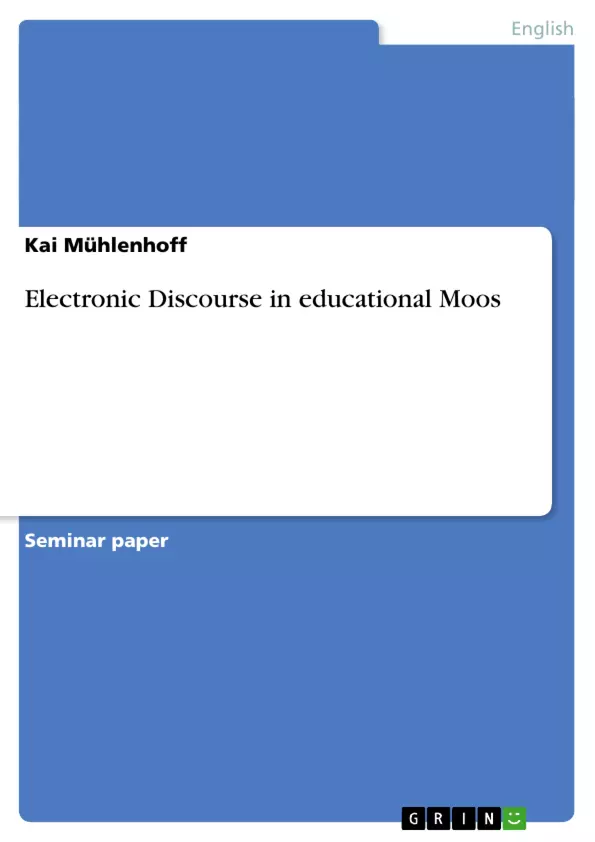[...] In our introduction, we first want to draw on the field of educational MOOs.
The upcoming of personal computers, it’s speedy with more advancing progress up
to this date and the easy accessibility at home or in educational institutions such as
schools and universities. Language Classes in universities for example, have already
led the 1980s to an ever increasing awareness that there is an almost unsustainable
and enormously large potential in its use for classroom purposes and other activities.
Although manifold, in the focus of our interest (for we are dealing with EFL learning
in our seminar) we measured L2 acquisition and the learnability of a Foreign
Language with the help of a computer program. We will thus narrow down several
possible choices we could make relating to teaching/learning software and choose
one of them. The program that we will thoroughly discuss in the next few chapters is
one that already, from a technological standpoint, has a long history. We must look
back to 1979 when the first virtual MUD (Multi-User Dungeon or Multi-User Domain),
the predecessor of the MOO (Multi-User Domain, Object-Oriented) comes into play.
MUDs do not crucially differ from MOOs, as becomes evident in their being virtually
the same program based on a similar code, the MOO, however, evolved from the
MUD as a more advanced version sporting some more additional and useful features
and making it therefore better to use for classroom purposes.1
First of all, what is a/the MOO? The MOO is a publicly accessible database,
available and accessible from anywhere on the world via network systems like, most
popular, the Internet. Users must log on to a server in order to gain access. Some of
this works via telnet or clients include MacMOOSE, Pueblo or encore Xpress. Curtis
and Nichols say that MOOs are “frequently referred to as text-based virtual realities”
(own italics, K.M, D.B) (TBVRs)2, because they are based on unformatted text, rather
than a colourful user graphic interface (UGI). The term object-oriented, hidden in
MOO, means MOO players can add new spaces in the form of rooms or other
objects to the classroom.
1 To provide the reader with a complete history on MUD/MOO environments would by far exceed the
length of this paper. For a complete history, see Holmevik, Jan Rune; Haynes, Cynthia:
MOOniversity:a student´s guide to online learning environments. 2000. p. 1 ff.
2 Curtis/Nichols 1993: n.p.
Inhaltsverzeichnis (Table of Contents)
- Introduction
- The discrepancy between synchronous electronic and spoken discourse
- Writing vs. speaking
- The provision of corrective feedback in the Münster-Vassar project
- Direct peer correction
- Feedback on grammar
- Indirect peer correction
- Students' inquiries after unknown vocabulary
- The supervision of peer utterances
- Direct peer correction
- Conclusion
Zielsetzung und Themenschwerpunkte (Objectives and Key Themes)
This research paper aims to explore the nature of computer programs and their relationship to Foreign Language Learning, specifically within the context of educational MOOS (Multi-User Object-Oriented) environments. It focuses on how electronic discourse takes place in virtual online environments, analyzing communication, interaction, and learning strategies between German and American students of English and German respectively.
- The discrepancy between synchronous electronic discourse and spoken discourse
- Turn-taking strategies in MOO discourse
- The provision of corrective feedback in the Münster-Vassar project
- The effectiveness of MOOS as a tool for online teaching and learning
- The influence of cultural background and language on online communication
Zusammenfassung der Kapitel (Chapter Summaries)
The introduction presents the research context by discussing the history and nature of MOOS and their potential for language learning. It introduces the Münster-Vassar project, a collaborative effort between the University of Münster and Vassar College, which provides the data for the study. This chapter also outlines the research questions guiding the analysis.
The second chapter explores the differences between synchronous electronic discourse and spoken discourse. It examines how writing and speaking differ, considering the impact of electronic communication on language use and turn-taking behaviors in a MOO environment.
Schlüsselwörter (Keywords)
This research paper focuses on the key concepts of electronic discourse, computer-mediated communication, synchronous CMC, turn-taking strategies, corrective feedback, educational MOOS, Münster-Vassar project, and the acquisition of foreign languages in virtual learning environments.
- Quote paper
- Kai Mühlenhoff (Author), 2003, Electronic Discourse in educational Moos, Munich, GRIN Verlag, https://www.grin.com/document/17885



